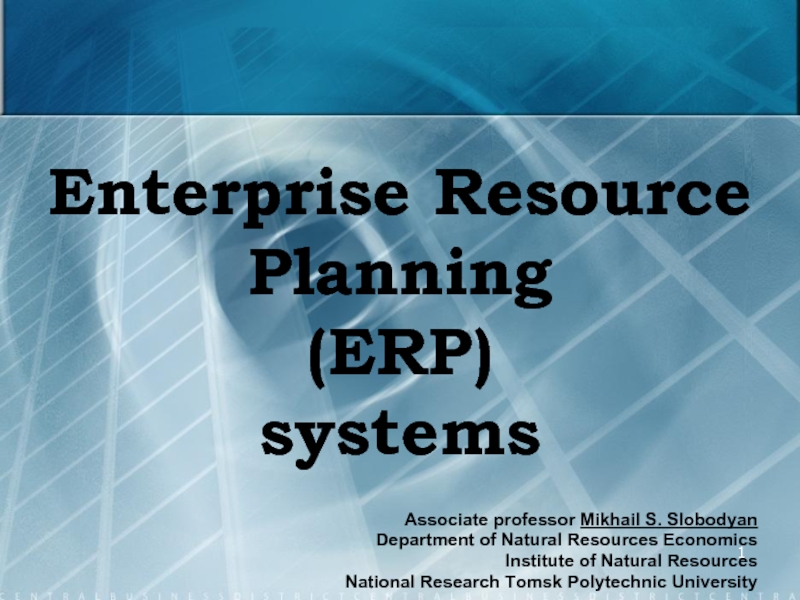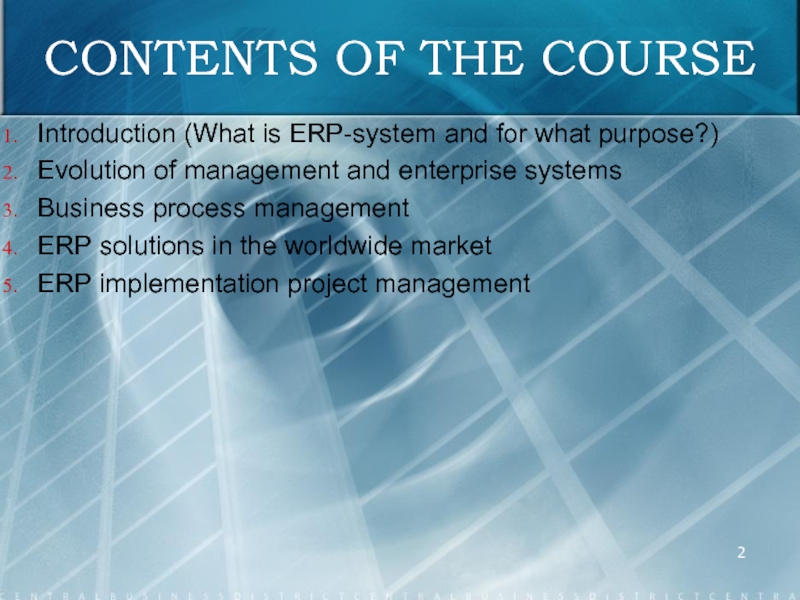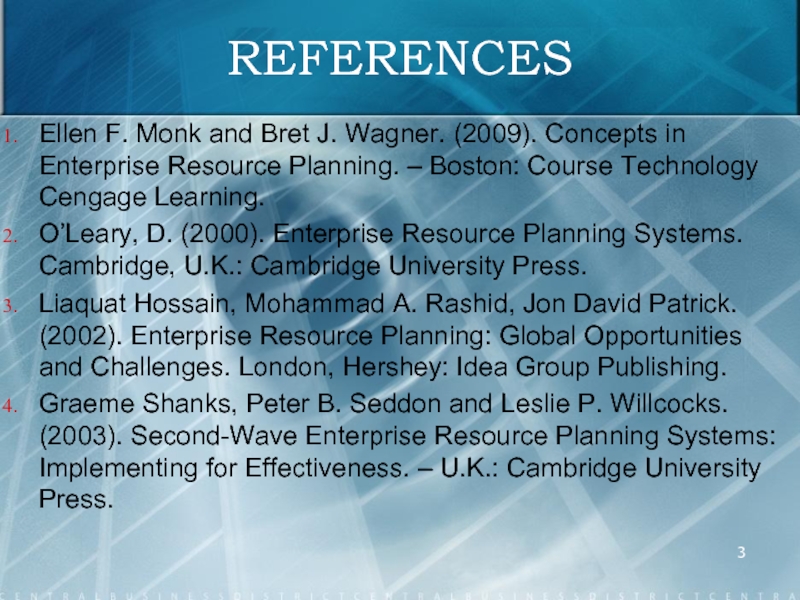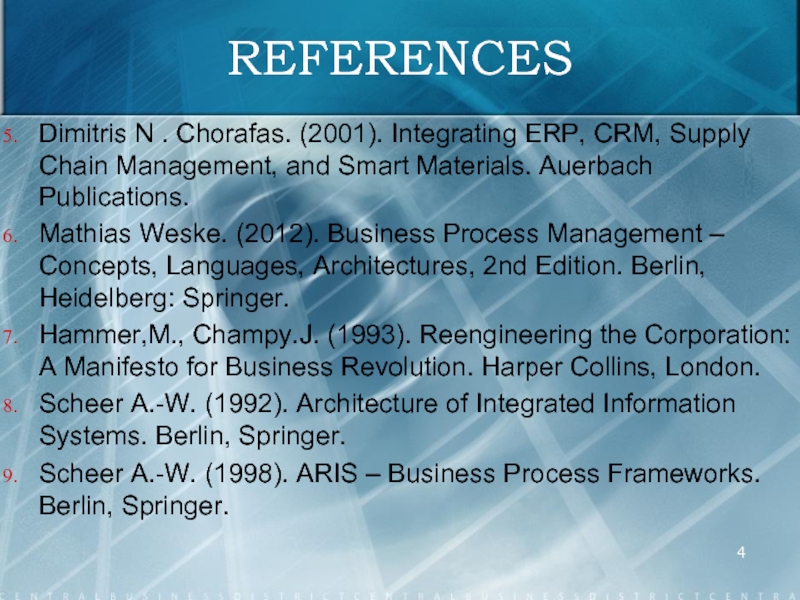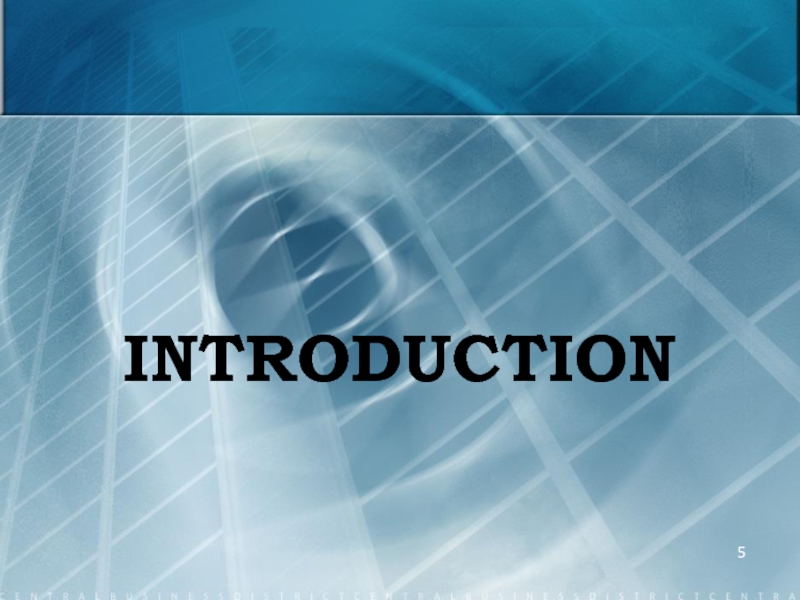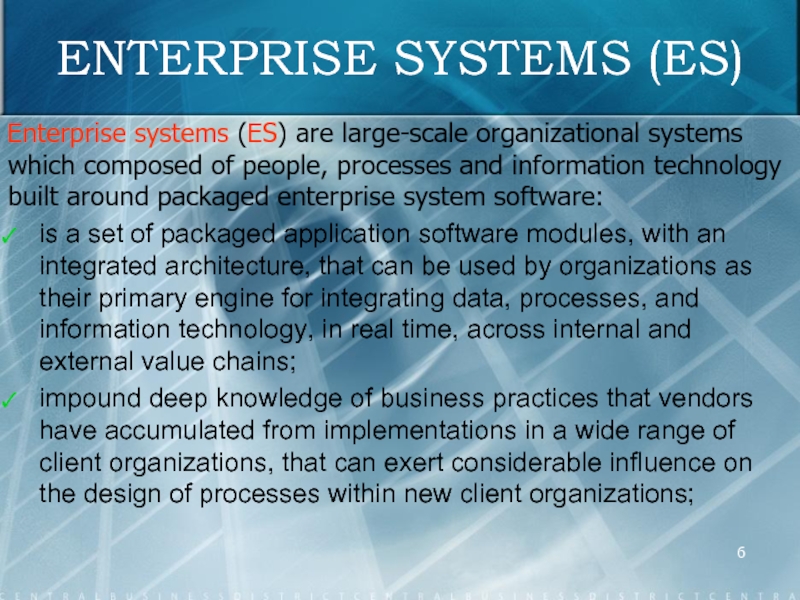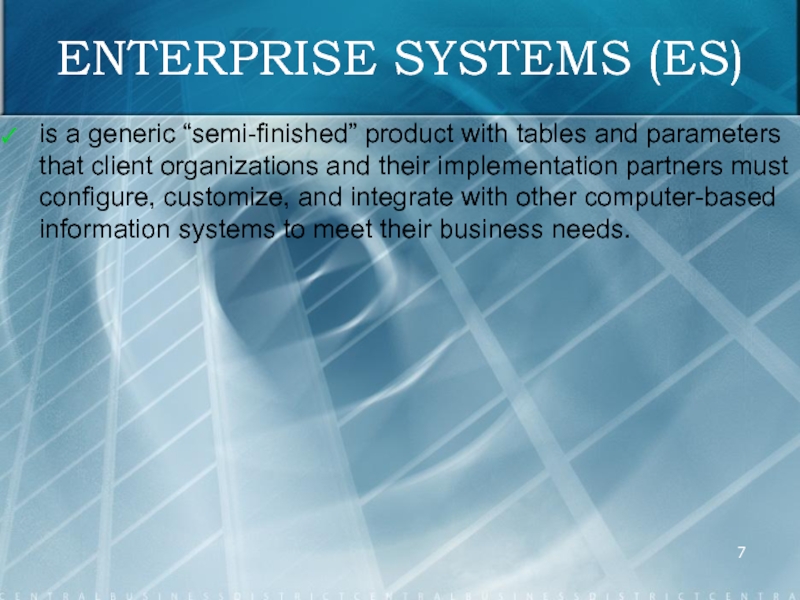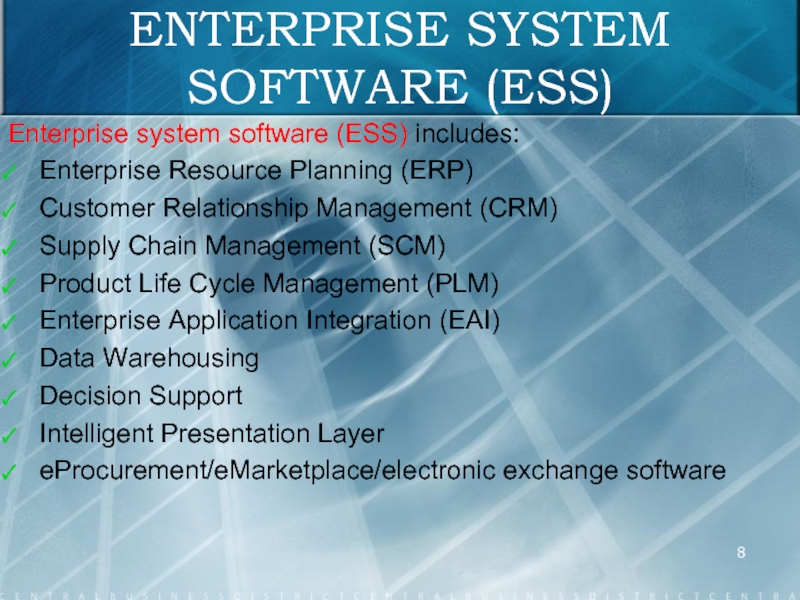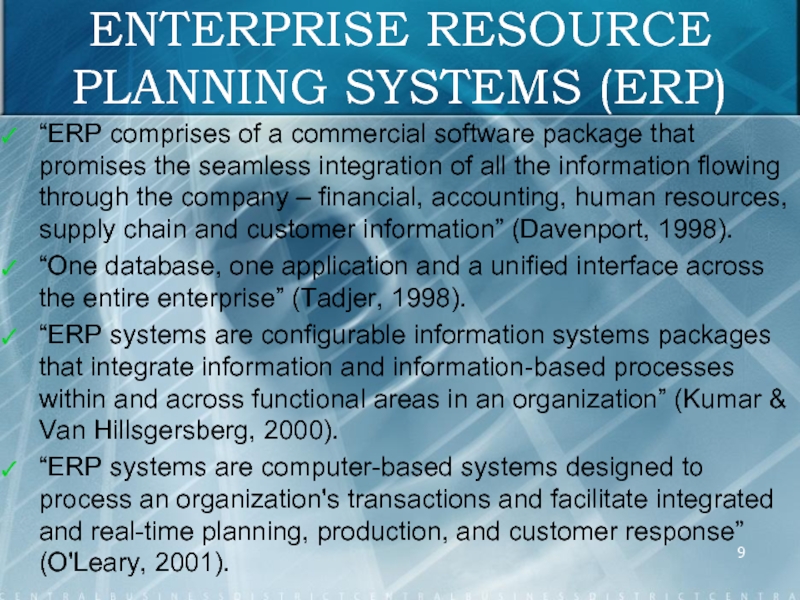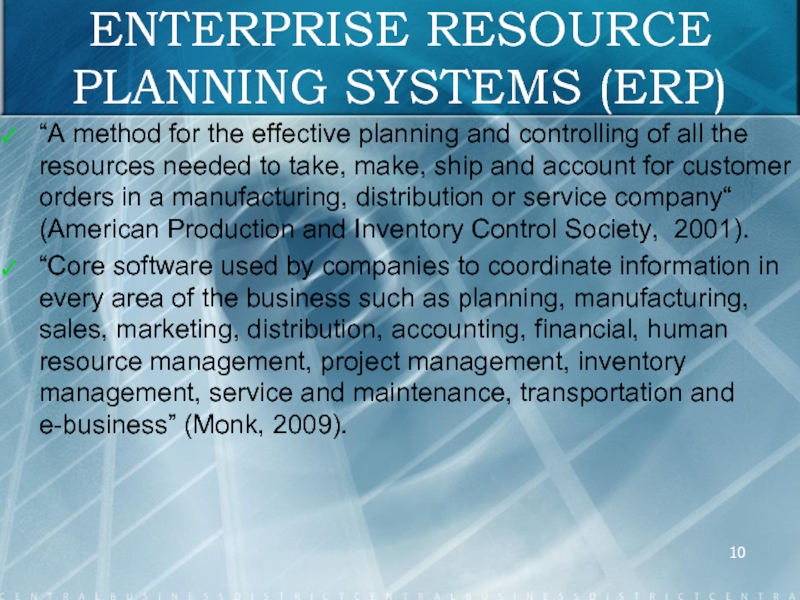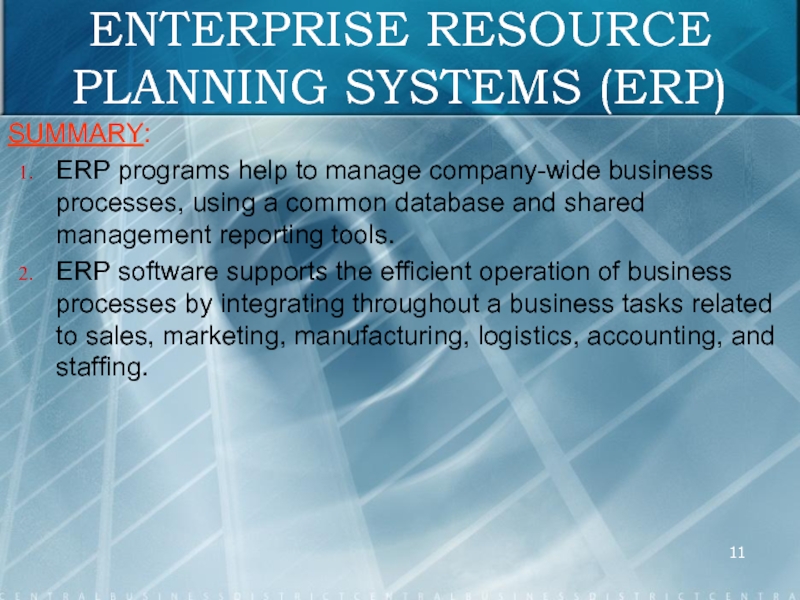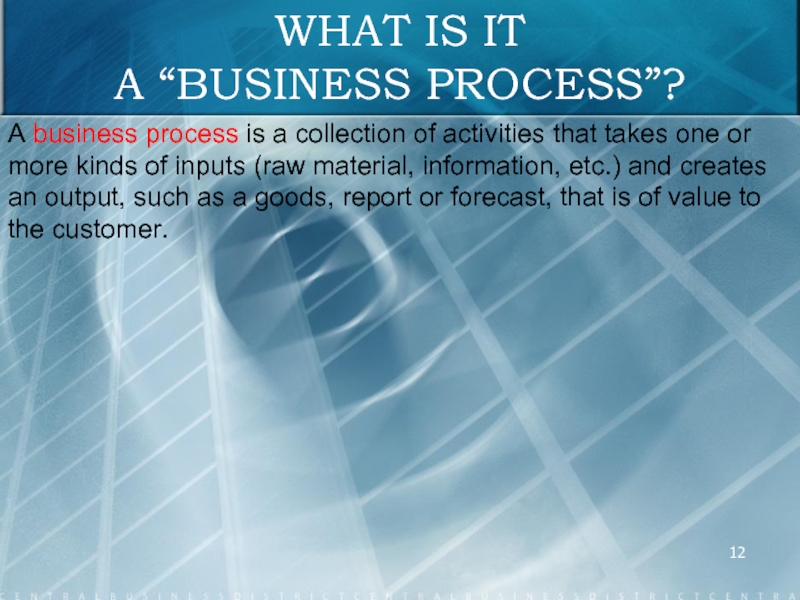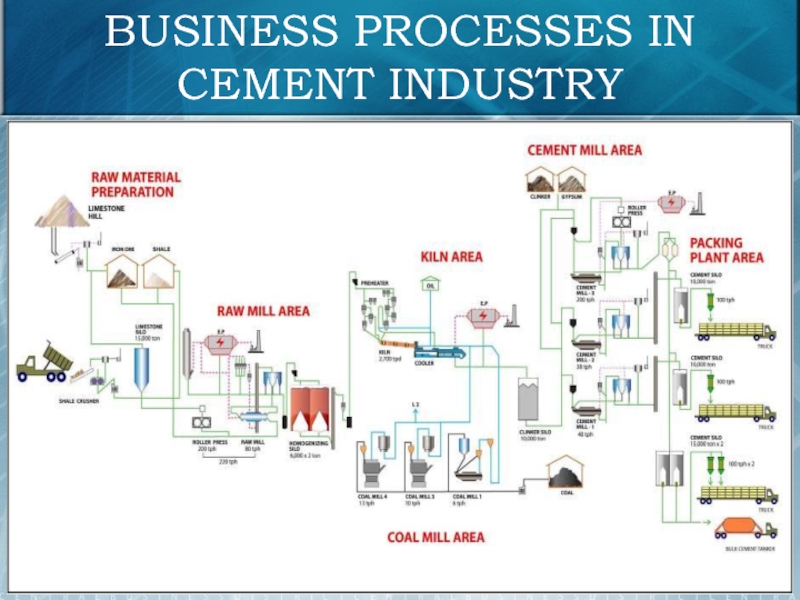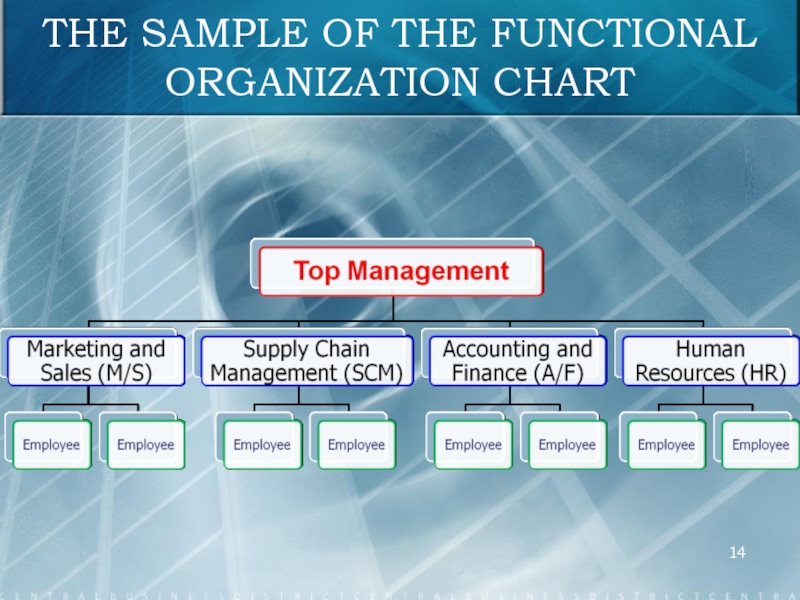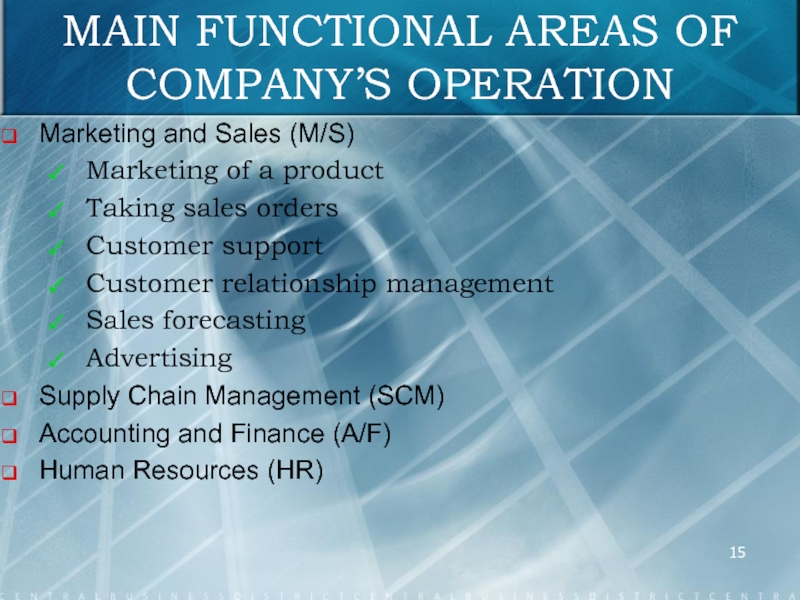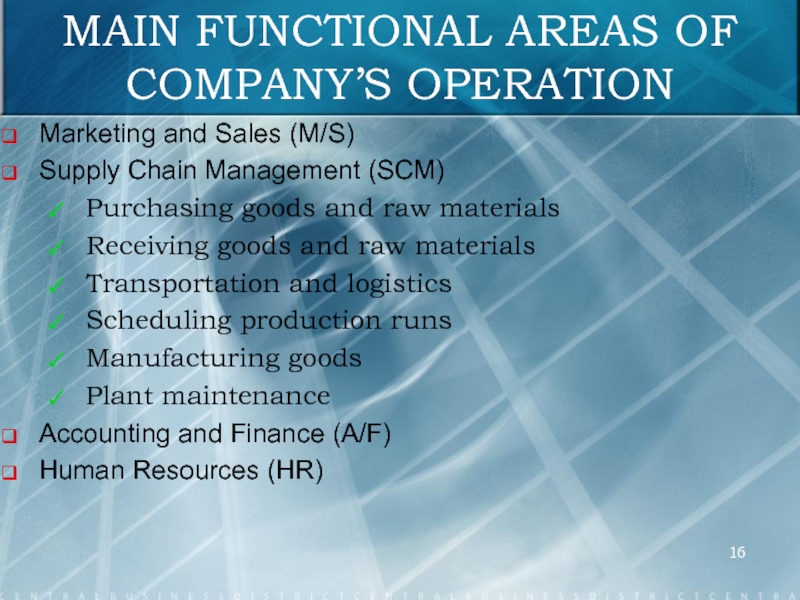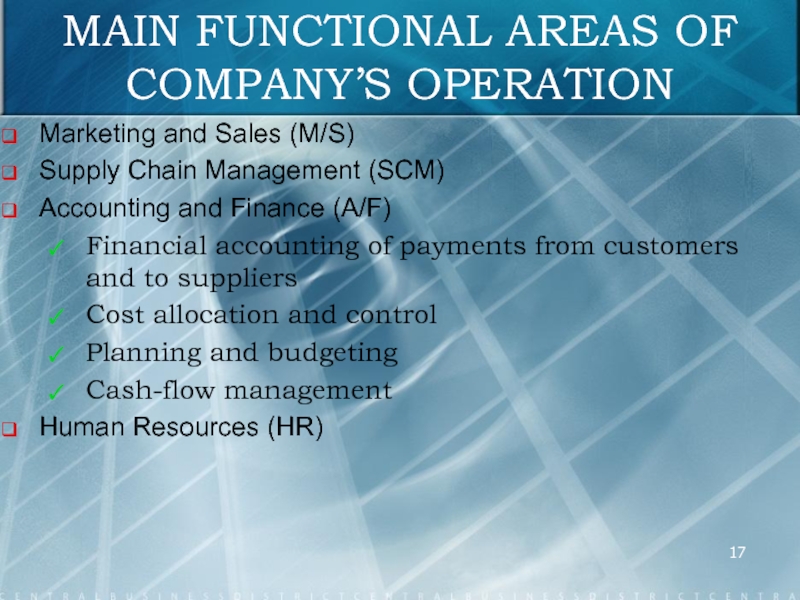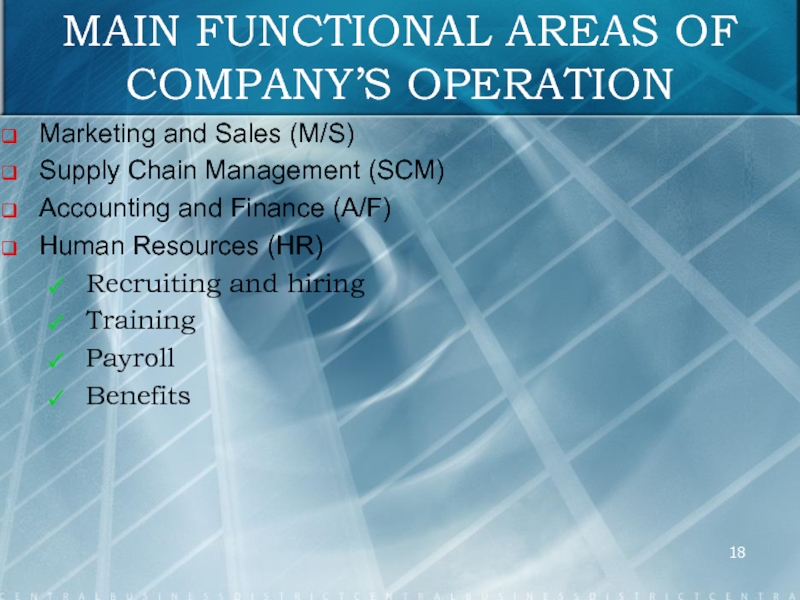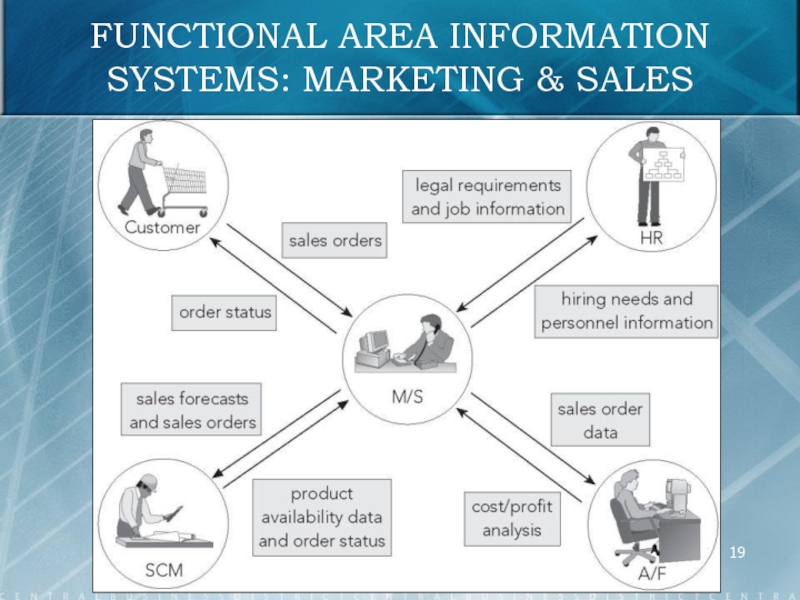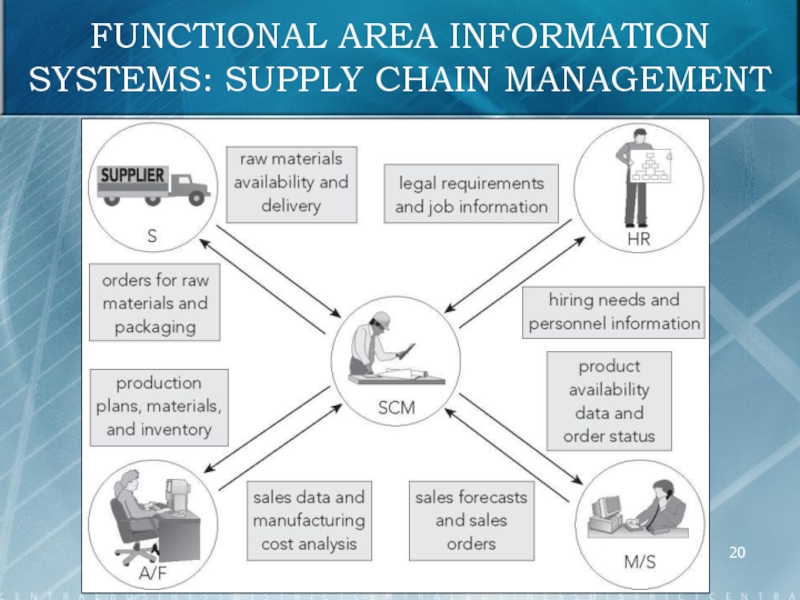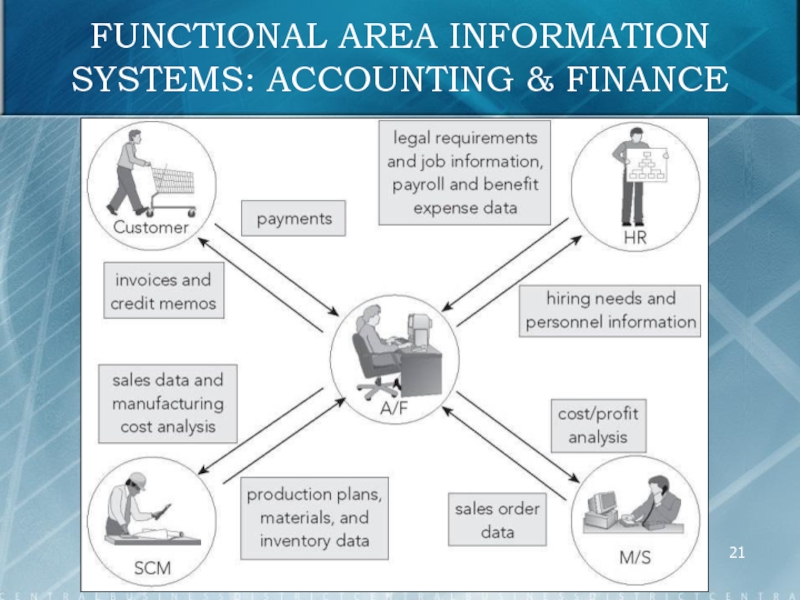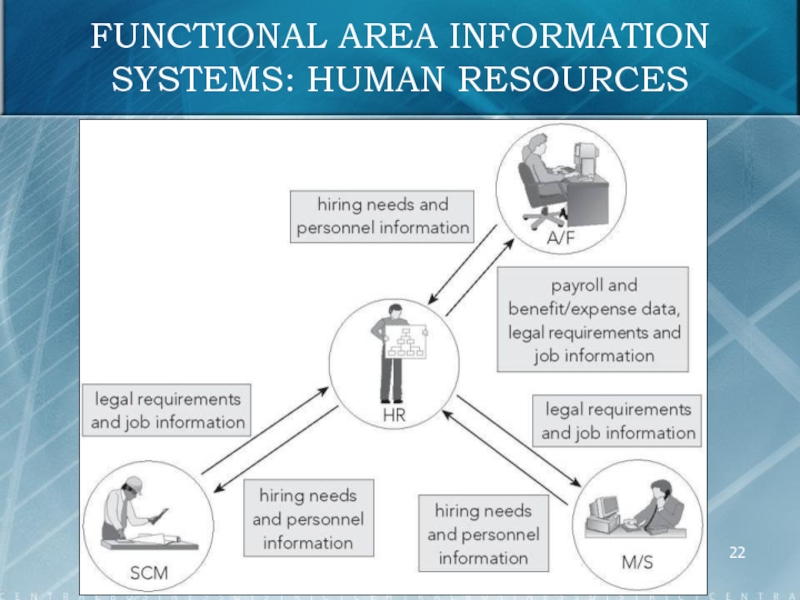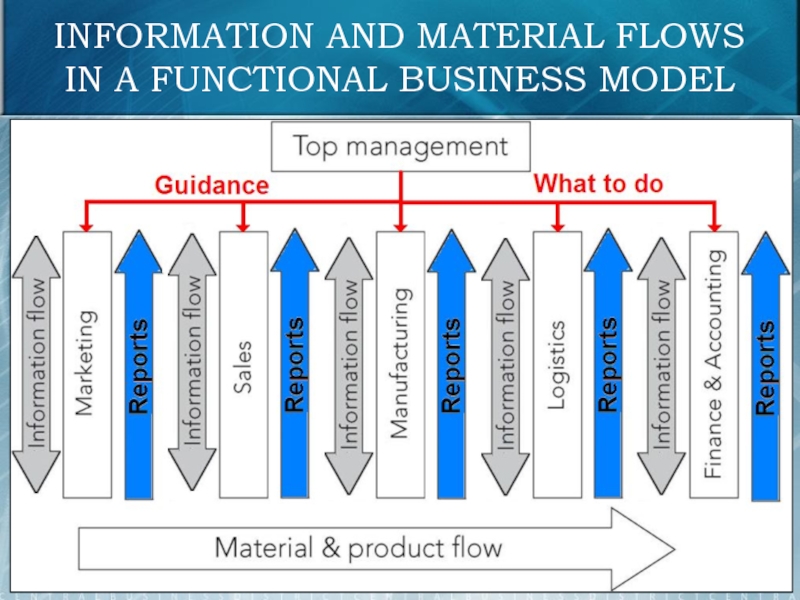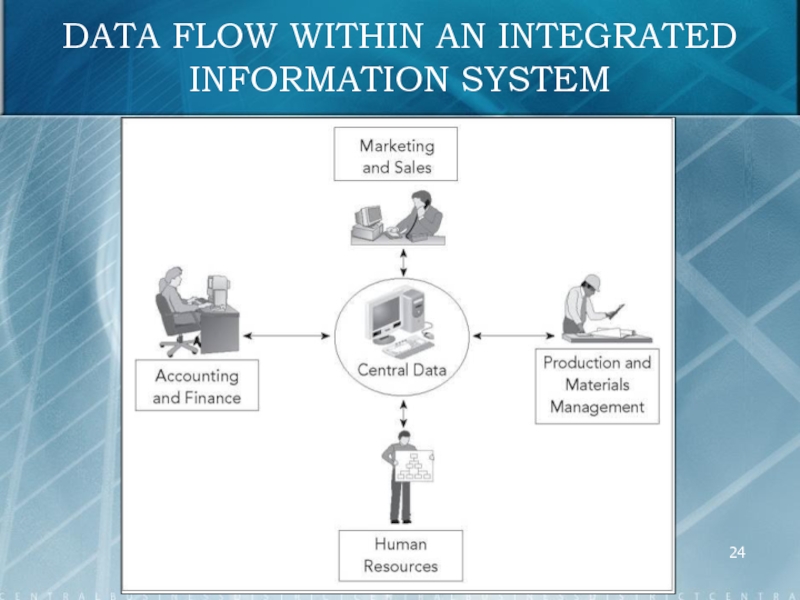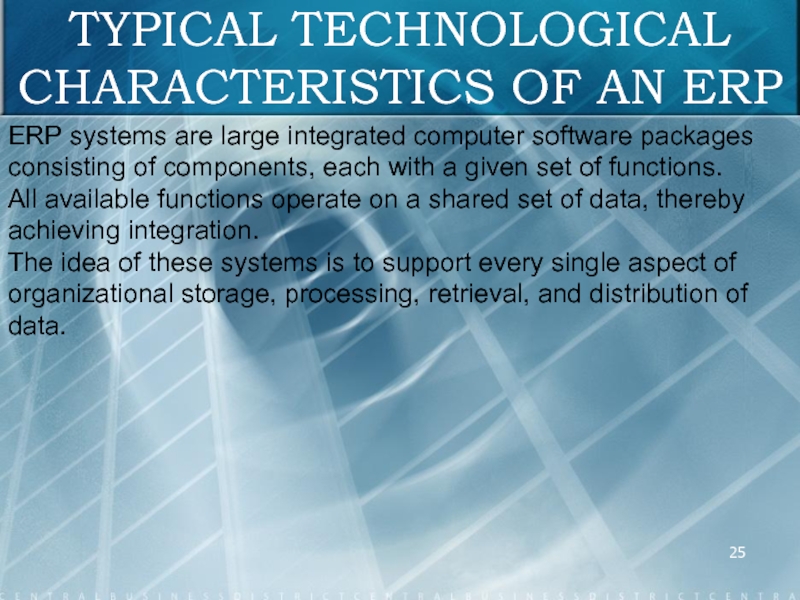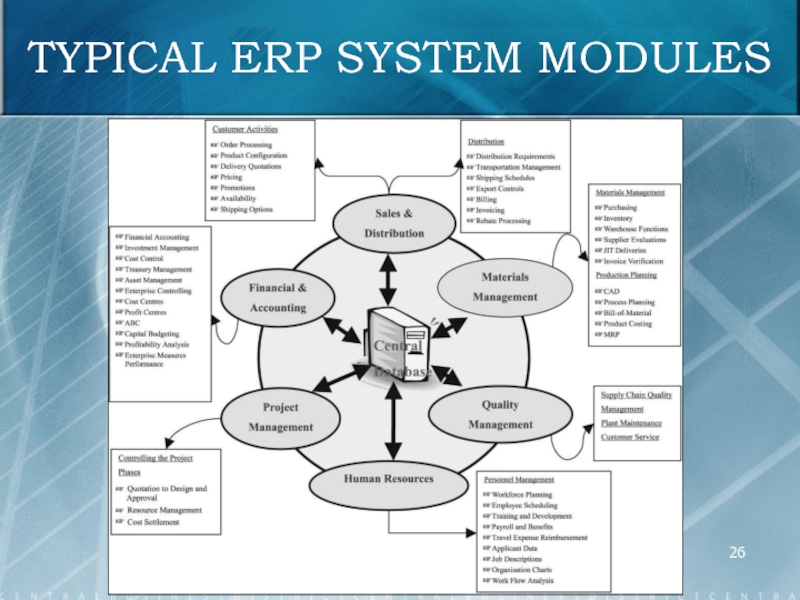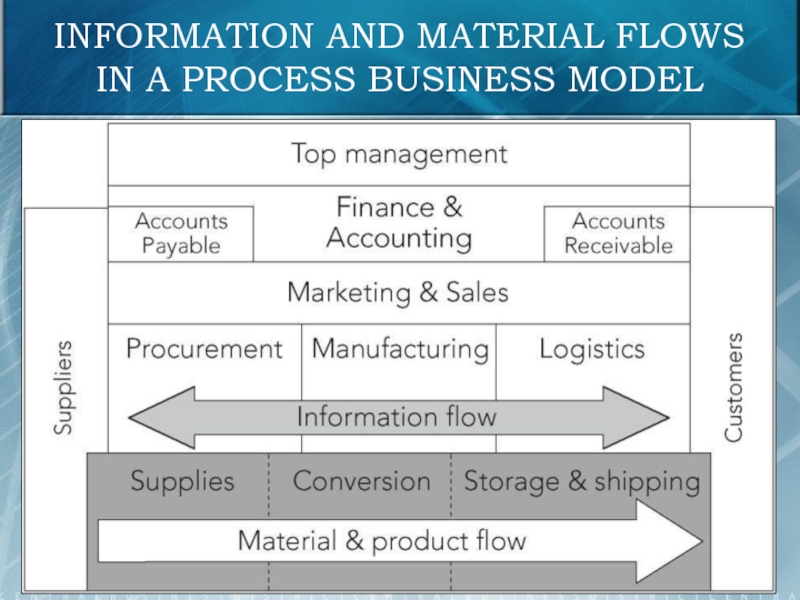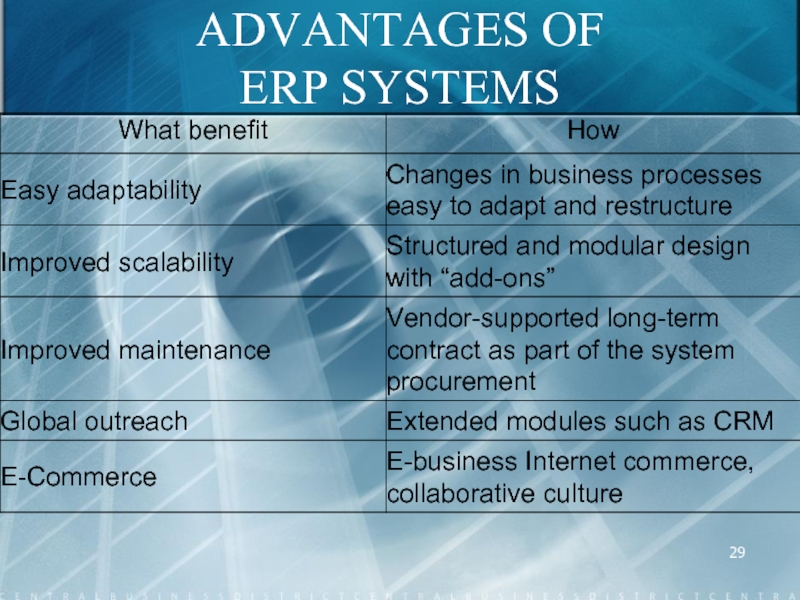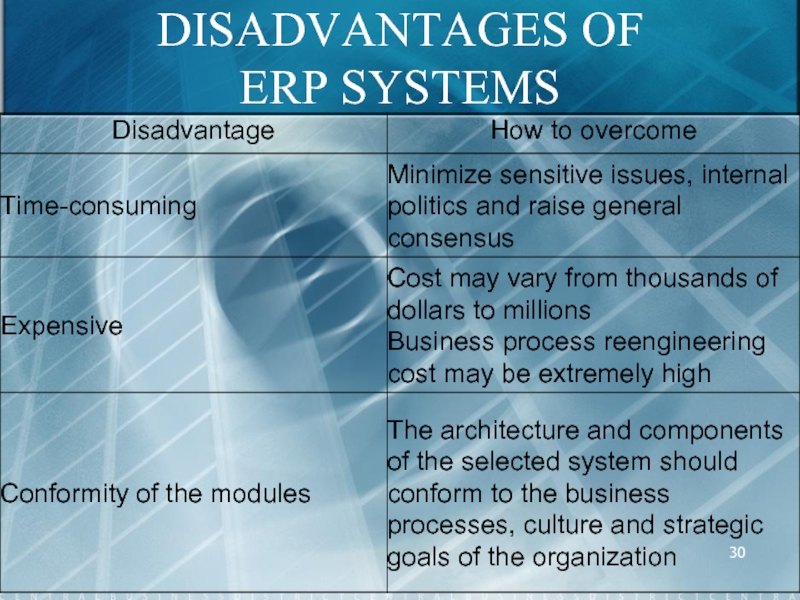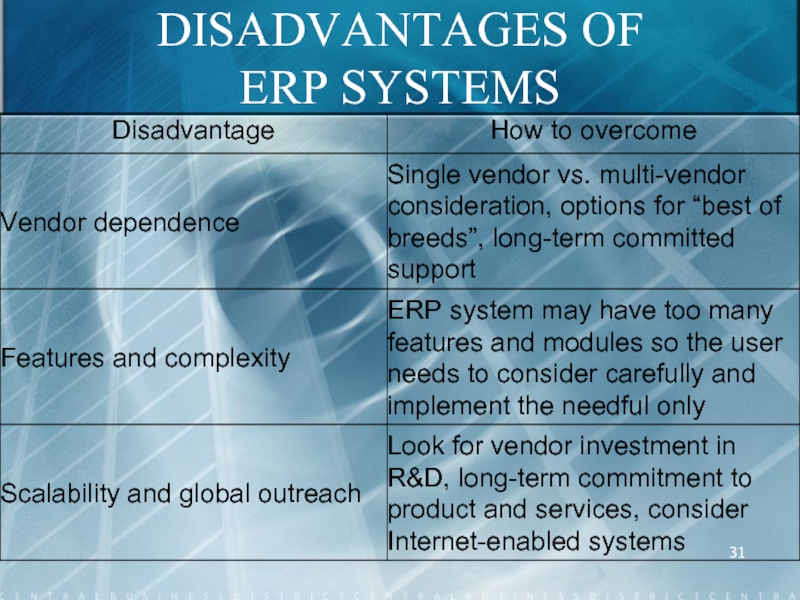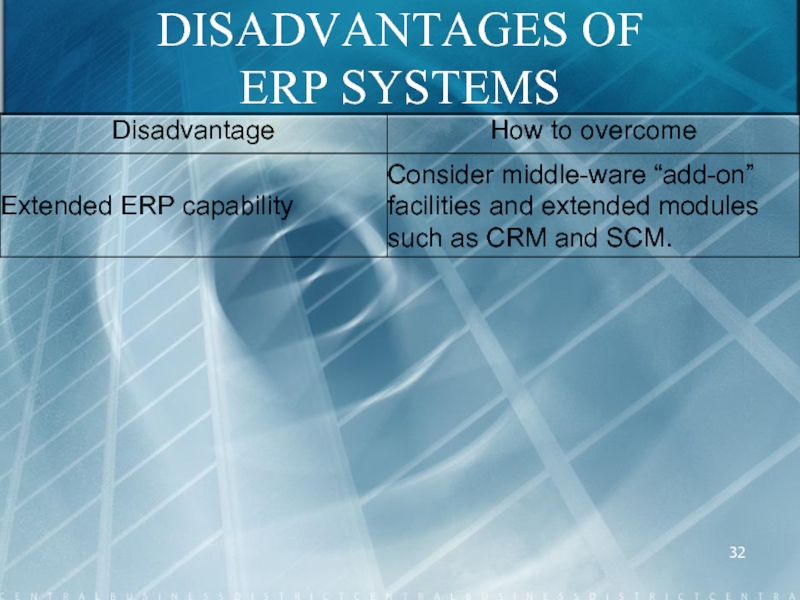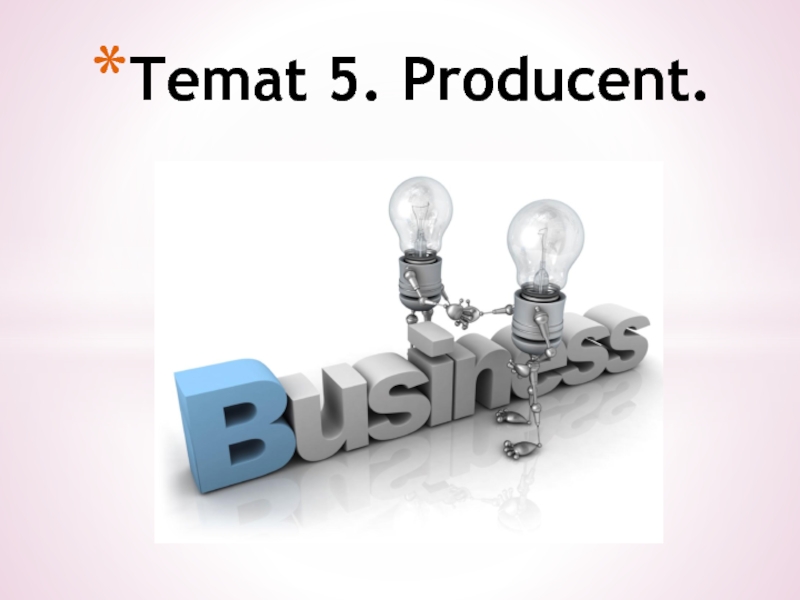- Главная
- Разное
- Дизайн
- Бизнес и предпринимательство
- Аналитика
- Образование
- Развлечения
- Красота и здоровье
- Финансы
- Государство
- Путешествия
- Спорт
- Недвижимость
- Армия
- Графика
- Культурология
- Еда и кулинария
- Лингвистика
- Английский язык
- Астрономия
- Алгебра
- Биология
- География
- Детские презентации
- Информатика
- История
- Литература
- Маркетинг
- Математика
- Медицина
- Менеджмент
- Музыка
- МХК
- Немецкий язык
- ОБЖ
- Обществознание
- Окружающий мир
- Педагогика
- Русский язык
- Технология
- Физика
- Философия
- Химия
- Шаблоны, картинки для презентаций
- Экология
- Экономика
- Юриспруденция
Enterprise Resource Planning (ERP) systems презентация
Содержание
- 1. Enterprise Resource Planning (ERP) systems
- 2. CONTENTS OF THE COURSE Introduction (What is
- 3. REFERENCES Ellen F. Monk and Bret J.
- 4. REFERENCES Dimitris N . Chorafas. (2001). Integrating ERP, CRM, Supply Chain
- 5. INTRODUCTION
- 6. ENTERPRISE SYSTEMS (ES) Enterprise systems (ES) are
- 7. ENTERPRISE SYSTEMS (ES) is a generic “semi-finished”
- 8. ENTERPRISE SYSTEM SOFTWARE (ESS) Enterprise system software
- 9. ENTERPRISE RESOURCE PLANNING SYSTEMS (ERP) “ERP comprises
- 10. ENTERPRISE RESOURCE PLANNING SYSTEMS (ERP) “A method
- 11. ENTERPRISE RESOURCE PLANNING SYSTEMS (ERP) SUMMARY: ERP
- 12. WHAT IS IT A “BUSINESS PROCESS”? A
- 13. BUSINESS PROCESSES IN CEMENT INDUSTRY
- 14. THE SAMPLE OF THE FUNCTIONAL ORGANIZATION CHART
- 15. MAIN FUNCTIONAL AREAS OF COMPANY’S OPERATION Marketing
- 16. MAIN FUNCTIONAL AREAS OF COMPANY’S OPERATION Marketing
- 17. MAIN FUNCTIONAL AREAS OF COMPANY’S OPERATION Marketing
- 18. MAIN FUNCTIONAL AREAS OF COMPANY’S OPERATION Marketing
- 19. FUNCTIONAL AREA INFORMATION SYSTEMS: MARKETING & SALES
- 20. FUNCTIONAL AREA INFORMATION SYSTEMS: SUPPLY CHAIN MANAGEMENT
- 21. FUNCTIONAL AREA INFORMATION SYSTEMS: ACCOUNTING & FINANCE
- 22. FUNCTIONAL AREA INFORMATION SYSTEMS: HUMAN RESOURCES
- 23. INFORMATION AND MATERIAL FLOWS IN A FUNCTIONAL BUSINESS MODEL
- 24. DATA FLOW WITHIN AN INTEGRATED INFORMATION SYSTEM
- 25. TYPICAL TECHNOLOGICAL CHARACTERISTICS OF AN ERP ERP
- 26. TYPICAL ERP SYSTEM MODULES
- 27. INFORMATION AND MATERIAL FLOWS IN A PROCESS BUSINESS MODEL
- 28. ADVANTAGES OF ERP SYSTEMS
- 29. ADVANTAGES OF ERP SYSTEMS
- 30. DISADVANTAGES OF ERP SYSTEMS
- 31. DISADVANTAGES OF ERP SYSTEMS
- 32. DISADVANTAGES OF ERP SYSTEMS
Слайд 2CONTENTS OF THE COURSE
Introduction (What is ERP-system and for what purpose?)
Evolution
of management and enterprise systems
Business process management
ERP solutions in the worldwide market
ERP implementation project management
Business process management
ERP solutions in the worldwide market
ERP implementation project management
Слайд 3REFERENCES
Ellen F. Monk and Bret J. Wagner. (2009). Concepts in Enterprise
Resource Planning. – Boston: Course Technology Cengage Learning.
O’Leary, D. (2000). Enterprise Resource Planning Systems. Cambridge, U.K.: Cambridge University Press.
Liaquat Hossain, Mohammad A. Rashid, Jon David Patrick. (2002). Enterprise Resource Planning: Global Opportunities and Challenges. London, Hershey: Idea Group Publishing.
Graeme Shanks, Peter B. Seddon and Leslie P. Willcocks. (2003). Second-Wave Enterprise Resource Planning Systems: Implementing for Effectiveness. – U.K.: Cambridge University Press.
O’Leary, D. (2000). Enterprise Resource Planning Systems. Cambridge, U.K.: Cambridge University Press.
Liaquat Hossain, Mohammad A. Rashid, Jon David Patrick. (2002). Enterprise Resource Planning: Global Opportunities and Challenges. London, Hershey: Idea Group Publishing.
Graeme Shanks, Peter B. Seddon and Leslie P. Willcocks. (2003). Second-Wave Enterprise Resource Planning Systems: Implementing for Effectiveness. – U.K.: Cambridge University Press.
Слайд 4REFERENCES
Dimitris N . Chorafas. (2001). Integrating ERP, CRM, Supply Chain Management, and Smart Materials. Auerbach Publications.
Mathias
Weske. (2012). Business Process Management – Concepts, Languages, Architectures, 2nd Edition. Berlin, Heidelberg: Springer.
Hammer,M., Champy.J. (1993). Reengineering the Corporation: A Manifesto for Business Revolution. Harper Collins, London.
Scheer A.-W. (1992). Architecture of Integrated Information Systems. Berlin, Springer.
Scheer A.-W. (1998). ARIS – Business Process Frameworks. Berlin, Springer.
Hammer,M., Champy.J. (1993). Reengineering the Corporation: A Manifesto for Business Revolution. Harper Collins, London.
Scheer A.-W. (1992). Architecture of Integrated Information Systems. Berlin, Springer.
Scheer A.-W. (1998). ARIS – Business Process Frameworks. Berlin, Springer.
Слайд 6ENTERPRISE SYSTEMS (ES)
Enterprise systems (ES) are large-scale organizational systems which composed
of people, processes and information technology built around packaged enterprise system software:
is a set of packaged application software modules, with an integrated architecture, that can be used by organizations as their primary engine for integrating data, processes, and information technology, in real time, across internal and external value chains;
impound deep knowledge of business practices that vendors have accumulated from implementations in a wide range of client organizations, that can exert considerable influence on the design of processes within new client organizations;
is a set of packaged application software modules, with an integrated architecture, that can be used by organizations as their primary engine for integrating data, processes, and information technology, in real time, across internal and external value chains;
impound deep knowledge of business practices that vendors have accumulated from implementations in a wide range of client organizations, that can exert considerable influence on the design of processes within new client organizations;
Слайд 7ENTERPRISE SYSTEMS (ES)
is a generic “semi-finished” product with tables and parameters
that client organizations and their implementation partners must configure, customize, and integrate with other computer-based information systems to meet their business needs.
Слайд 8ENTERPRISE SYSTEM SOFTWARE (ESS)
Enterprise system software (ESS) includes:
Enterprise Resource Planning (ERP)
Customer
Relationship Management (CRM)
Supply Chain Management (SCM)
Product Life Cycle Management (PLM)
Enterprise Application Integration (EAI)
Data Warehousing
Decision Support
Intelligent Presentation Layer
eProcurement/eMarketplace/electronic exchange software
Supply Chain Management (SCM)
Product Life Cycle Management (PLM)
Enterprise Application Integration (EAI)
Data Warehousing
Decision Support
Intelligent Presentation Layer
eProcurement/eMarketplace/electronic exchange software
Слайд 9ENTERPRISE RESOURCE PLANNING SYSTEMS (ERP)
“ERP comprises of a commercial software package
that promises the seamless integration of all the information flowing through the company – financial, accounting, human resources, supply chain and customer information” (Davenport, 1998).
“One database, one application and a unified interface across the entire enterprise” (Tadjer, 1998).
“ERP systems are configurable information systems packages that integrate information and information-based processes within and across functional areas in an organization” (Kumar & Van Hillsgersberg, 2000).
“ERP systems are computer-based systems designed to process an organization's transactions and facilitate integrated and real-time planning, production, and customer response” (O'Leary, 2001).
“One database, one application and a unified interface across the entire enterprise” (Tadjer, 1998).
“ERP systems are configurable information systems packages that integrate information and information-based processes within and across functional areas in an organization” (Kumar & Van Hillsgersberg, 2000).
“ERP systems are computer-based systems designed to process an organization's transactions and facilitate integrated and real-time planning, production, and customer response” (O'Leary, 2001).
Слайд 10ENTERPRISE RESOURCE PLANNING SYSTEMS (ERP)
“A method for the effective planning and
controlling of all the resources needed to take, make, ship and account for customer orders in a manufacturing, distribution or service company“ (American Production and Inventory Control Society, 2001).
“Core software used by companies to coordinate information in every area of the business such as planning, manufacturing, sales, marketing, distribution, accounting, financial, human resource management, project management, inventory management, service and maintenance, transportation and e-business” (Monk, 2009).
“Core software used by companies to coordinate information in every area of the business such as planning, manufacturing, sales, marketing, distribution, accounting, financial, human resource management, project management, inventory management, service and maintenance, transportation and e-business” (Monk, 2009).
Слайд 11ENTERPRISE RESOURCE PLANNING SYSTEMS (ERP)
SUMMARY:
ERP programs help to manage company-wide business
processes, using a common database and shared management reporting tools.
ERP software supports the efficient operation of business processes by integrating throughout a business tasks related to sales, marketing, manufacturing, logistics, accounting, and staffing.
ERP software supports the efficient operation of business processes by integrating throughout a business tasks related to sales, marketing, manufacturing, logistics, accounting, and staffing.
Слайд 12WHAT IS IT
A “BUSINESS PROCESS”?
A business process is a collection of
activities that takes one or more kinds of inputs (raw material, information, etc.) and creates an output, such as a goods, report or forecast, that is of value to the customer.
Слайд 15MAIN FUNCTIONAL AREAS OF COMPANY’S OPERATION
Marketing and Sales (M/S)
Marketing of a
product
Taking sales orders
Customer support
Customer relationship management
Sales forecasting
Advertising
Supply Chain Management (SCM)
Accounting and Finance (A/F)
Human Resources (HR)
Taking sales orders
Customer support
Customer relationship management
Sales forecasting
Advertising
Supply Chain Management (SCM)
Accounting and Finance (A/F)
Human Resources (HR)
Слайд 16MAIN FUNCTIONAL AREAS OF COMPANY’S OPERATION
Marketing and Sales (M/S)
Supply Chain Management
(SCM)
Purchasing goods and raw materials
Receiving goods and raw materials
Transportation and logistics
Scheduling production runs
Manufacturing goods
Plant maintenance
Accounting and Finance (A/F)
Human Resources (HR)
Purchasing goods and raw materials
Receiving goods and raw materials
Transportation and logistics
Scheduling production runs
Manufacturing goods
Plant maintenance
Accounting and Finance (A/F)
Human Resources (HR)
Слайд 17MAIN FUNCTIONAL AREAS OF COMPANY’S OPERATION
Marketing and Sales (M/S)
Supply Chain Management
(SCM)
Accounting and Finance (A/F)
Financial accounting of payments from customers and to suppliers
Cost allocation and control
Planning and budgeting
Cash-flow management
Human Resources (HR)
Accounting and Finance (A/F)
Financial accounting of payments from customers and to suppliers
Cost allocation and control
Planning and budgeting
Cash-flow management
Human Resources (HR)
Слайд 18MAIN FUNCTIONAL AREAS OF COMPANY’S OPERATION
Marketing and Sales (M/S)
Supply Chain Management
(SCM)
Accounting and Finance (A/F)
Human Resources (HR)
Recruiting and hiring
Training
Payroll
Benefits
Accounting and Finance (A/F)
Human Resources (HR)
Recruiting and hiring
Training
Payroll
Benefits
Слайд 25TYPICAL TECHNOLOGICAL CHARACTERISTICS OF AN ERP
ERP systems are large integrated computer
software packages consisting of components, each with a given set of functions.
All available functions operate on a shared set of data, thereby achieving integration.
The idea of these systems is to support every single aspect of organizational storage, processing, retrieval, and distribution of data.
All available functions operate on a shared set of data, thereby achieving integration.
The idea of these systems is to support every single aspect of organizational storage, processing, retrieval, and distribution of data.
